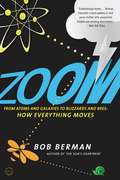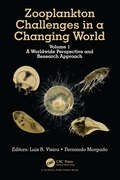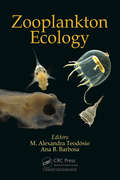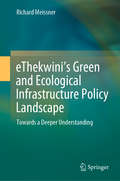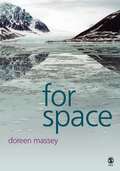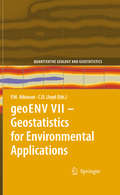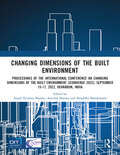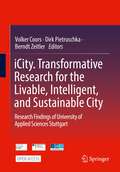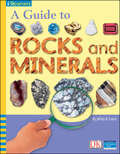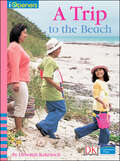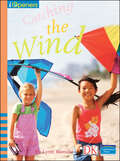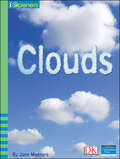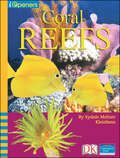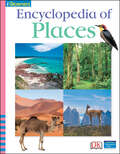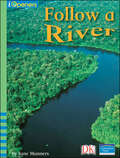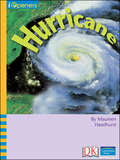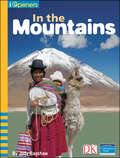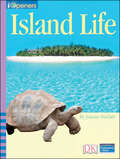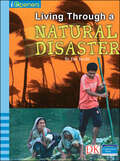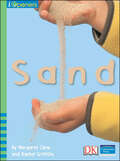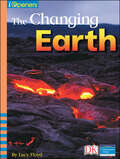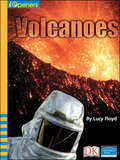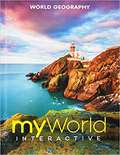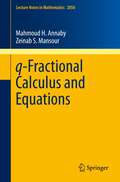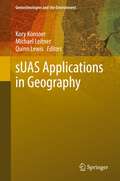- Table View
- List View
Zoom: How Everything Moves
by Bob BermanFrom the speed of light to moving mountains--and everything in between--ZOOM explores how the universe and its objects move.If you sit as still as you can in a quiet room, you might be able to convince yourself that nothing is moving. But air currents are still wafting around you. Blood rushes through your veins. The atoms in your chair jiggle furiously. In fact, the planet you are sitting on is whizzing through space thirty-five times faster than the speed of sound.Natural motion dominates our lives and the intricate mechanics of the world around us. In ZOOM, Bob Berman explores how motion shapes every aspect of the universe, literally from the ground up. With an entertaining style and a gift for distilling the wondrous, Berman spans astronomy, geology, biology, meteorology, and the history of science, uncovering how clouds stay aloft, how the Earth's rotation curves a home run's flight, and why a mosquito's familiar whine resembles a telephone's dial tone.For readers who love to get smarter without realizing it, ZOOM bursts with science writing at its best.
Zooplankton Challenges in a Changing World: Volume 1: A Worldwide Perspective and Research Approach
by Luis R. Vieira Fernando MorgadoPlankton populations have lived in the oceans for hundreds of millions of years, performing essential functions within marine ecosystems. This book explores emerging and current topics in marine ecosystem plankton research, focusing on pelagic diversity, functioning, and productivity from a multidisciplinary structural and functional view. It also examines the context of environmental stressors and global Climate Change Research and Policy. The book represents a contribution from a team of researchers from several regions of the world with a common mission to enhance readers' understanding of current ocean science and marine biology while pointing towards future directions.
Zooplankton Ecology
by M. Alexandra Teodósio and Ana B. BarbosaThis book aims at providing students and researchers an advanced integrative overview on zooplankton ecology, covering marine and freshwater organisms, from microscopic phagotrophic protists, to macro-jellyfishes and active fish larvae. The first book section addresses zooplanktonic organisms and processes, the second section is devoted to zooplankton spatial and temporal distribution patterns and trophic dynamics, and the final section is dedicated to emergent methodological approaches (e.g., omics). Book chapters include comprehensive synthesis, observational and manipulative studies, and sediment-based analysis, a vibrant imprint of benthic-pelagic coupling and ecosystem connectivity. Most chapters also address the impacts of anticipated environmental changes (e.g., warming, acidification).
eThekwini’s Green and Ecological Infrastructure Policy Landscape: Towards a Deeper Understanding
by Richard MeissnerThis book offers the reader a deeper understanding of the eThekwini Metropolitan Municipality’s green and ecological infrastructure policy landscape. The author utilises the PULSE3 analytical framework to conduct an in-depth examination and to show how experts frame and implement the municipality’s green and ecological infrastructure strategies and projects. Although the initial purpose of this book was to investigate the role of green and ecological infrastructures in eThekwini’s water security aspirations, the author realised that climate change adaptation and mitigation play a more central role in motivating the municipality to develop and implement such science-driven projects. To be sure, science that is informed by a positivist paradigm, guides how, where and when the municipality should develop green and ecological infrastructures. Furthermore, a positivistic stance is generated in this policy landscape, where science and politics meet at a local government level, and the book offers an insight into the science–policy interface, as well as the normative and value orientations that positivism often ignores. The book also shows the usefulness of the PULSE3 framework and how it can assist scientists in all fields to gain a deeper understanding of the complications that are faced by humankind. This book fills a market gap by providing a view of how scientists think about problems and how to solve them by using established paradigms and theories.
for space
by Doreen MasseyIn this book, Doreen Massey makes an impassioned argument for revitalising our imagination of space. She takes on some well-established assumptions from philosophy, and some familiar ways of characterising the twenty-first century world, and shows how they restrain our understanding of both the challenge and the potential of space. The way we think about space matters. It inflects our understandings of the world, our attitudes to others, our politics. It affects, for instance, the way we understand globalisation, the way we approach cities, the way we develop, and practice, a sense of place. If time is the dimension of change then space is the dimension of the social: the contemporaneous co-existence of others. That is its challenge, and one that has been persistently evaded. For Space pursues its argument through philosophical and theoretical engagement, and through telling personal and political reflection. Doreen Massey asks questions such as how best to characterise these so-called spatial times, how it is that implicit spatial assumptions inflect our politics, and how we might develop a responsibility for place beyond place. This book is 'for space' in that it argues for a reinvigoration of the spatiality of our implicit cosmologies. For Space is essential reading for anyone interested in space and the spatial turn in the social sciences and humanities. Serious, and sometimes irreverent, it is a compelling manifesto: for re-imagining spaces for these times and facing up to their challenge.
geoENV VII – Geostatistics for Environmental Applications
by C. D. Lloyd Peter M. AtkinsonThis volume brings together selected contributions from geoENV 2008, the 7th International Conference on Geostatistics for Environmental Applications, held in Southampton, UK, in September 2008. This book presents the state-of-the-art in geostatistics for the environmental sciences. It includes a wide range of methodological advances and applications. It offers insight and guidance for researchers, professionals, graduate students and others seeking information on the latest perspectives in the field. The rich body of applications will enable those new to geostatistics to assess the utility of the methods for their own applications. The book includes 35 chapters on topics as diverse as methodological developments, applications in the soil sciences, climatology, pollution, health, wildlife mapping, fisheries and remote sensing, amongst other areas. With its focus on environmental applications of geostatistics, rather than the more traditional geostatistical remit of mining and petroleum exploration, this book is part of a series that presents an invaluable resource. This book will be a first port of call for those who wish to apply geostatistical methods in the environmental sciences.
i-Converge: Proceedings of the International Conference on Changing Dimensions of the Built Environment (i-Converge 2022)
by Aanchal SharmaThe conference presented a multidisciplinary interactive forum to researchers, students, academicians, industry professionals, policymakers and scientists focusing on three key tracks, namely, Architecture and Built Environment, Planning and Practices, and Design and Society. Presenters shared experiences, research results, and scholarly contributions and discussed the practical challenges encountered and solutions to be adopted. The selected contributions are enclosed within the proceedings.
iCity. Transformative Research for the Livable, Intelligent, and Sustainable City: Research Findings of University of Applied Sciences Stuttgart
by Volker Coors Dirk Pietruschka Berndt ZeitlerThis open access book presents the exciting research results of the BMBF funded project iCity carried out at University of Applied Science Stuttgart to help cities to become more liveable, intelligent and sustainable, to become a LIScity. The research has been pursued with industry partners and NGOs from 2017 to 2020. A LIScity is increasingly digitally networked, uses resources efficiently, and implements intelligent mobility concepts. It guarantees the supply of its grid-bound infrastructure with a high proportion of renewable energy. Intelligent cities are increasingly human-centered, integrative, and flexible, thus placing the well-being of the citizens at the center of developments to increase the quality of life. The articles in this book cover research aimed to meet these criteria. The book covers research in the fields of energy (i.e. algorithms for heating and energy storage systems, simulation programs for thermal local heating supply, runtime optimization of combined heat and power (CHP), natural ventilation), mobility (i.e. charging distribution and deep learning, innovative emission-friendly mobility, routing apps, zero-emission urban logistics, augmented reality, artificial intelligence for individual route planning, mobility behavior), information platforms (i.e. 3DCity models in city planning: sunny places visualization, augmented reality for windy cities, internet of things (IoT) monitoring to visualize device performance, storing and visualizing dynamic energy data of smart cities), and buildings and city planning (i.e. sound insulation of sustainable facades and balconies, multi-camera mobile systems for inspection of tunnels, building-integrated photovoltaics (BIPV) as active façade elements, common space, the building envelopes potential in smart sustainable cities).
iOpener: A Guide to Rocks and Minerals (iOpeners)
by Jeffrey B. FuerstThis book covers everything you need to know about rocks and minerals, including the different types of rocks, examples of key minerals, how to identify minerals, and what various rocks and minerals are used for today. A glossary and index highlight key terms and subject matter, while discussion questions aid in reading comprehension.Grade: 4Subject: Earth ScienceGenre: ReferenceComprehension Skill/Strategy: Classify/CategorizeDiagnostic Reading Assessment (DRA/EDL): 40Guided Reading Level: TLexile Level: 750LDK's iOpeners equip K-6 students with the skills and strategies they need to access and comprehend nonfiction so that they are not only learning to read but reading to learn. The combination of high-interest content and eye-popping photography of iOpeners brings science and social studies topics to life, raises student achievement in reading, and boosts standardized test scores.
iOpener: A Trip to the Beach (iOpeners)
by Deborah KekewichIn A Trip to the Beach, a family explores the beach and finds animals all over: by the water, in the sand, and at the shoreline. This 44-word book for young readers will introduce new words with clear, fun photographs of the beach and its inhabitants. It also includes discussion questions to aid in reading comprehension.Grade: KindergartenSubject: GeographyGenre: Nonfiction NarrativeComprehension Skill/Strategy: Identify Main Idea/DetailsDiagnostic Reading Assessment (DRA/EDL): 6Guided Reading Level: DLexile Level: 6DK's iOpeners equip K-6 students with the skills and strategies they need to access and comprehend nonfiction so that they are not only learning to read but reading to learn. The combination of high-interest content and eye-popping photography of iOpeners brings science and social studies topics to life, raises student achievement in reading, and boosts standardized test scores.
iOpener: Catching the Wind (iOpeners)
by Lynn BlancheThis 470-word book covers what wind is, how it helps things move, and when wind is too much. This title includes a glossary of terms, helpful diagrams, and discussion questions to aid in reading comprehension. Grade: 2Subject: Physical ScienceGenre: Informational TextComprehension Skill/Strategy: Identify Cause and EffectDiagnostic Reading Assessment (DRA/EDL): 20Guided Reading Level: KLexile Level: 20DK's iOpeners equip K-6 students with the skills and strategies they need to access and comprehend nonfiction so that they are not only learning to read but reading to learn. The combination of high-interest content and eye-popping photography of iOpeners brings science and social studies topics to life, raises student achievement in reading, and boosts standardized test scores.
iOpener: Clouds (iOpeners)
by Jane MannersIn Clouds, confident young readers will learn all about the stages of the water cycle and all the kinds of clouds. Full-page photography showcases all the cloud types and their shapes, while discussion questions will aid in comprehension of this 206-word book.Grade: 1Subject: Earth ScienceGenre: Informational TextComprehension Skill/Strategy: VisualizeDiagnostic Reading Assessment (DRA/EDL): 16Guided Reading Level: ILexile Level: 16DK's iOpeners equip K-6 students with the skills and strategies they need to access and comprehend nonfiction so that they are not only learning to read but reading to learn. The combination of high-interest content and eye-popping photography of iOpeners brings science and social studies topics to life, raises student achievement in reading, and boosts standardized test scores.
iOpener: Coral Reefs (iOpeners)
by Sydnie Meltzer KleinhenzThis book covers everything about the many kinds of coral reefs, the creatures that live in a reef ecosystem, and coral reefs around the world. Diagrams, maps, and photographs bring the subject to life, while a glossary, an index, and discussion questions aid in reading comprehension.Grade: 4Subject: Life ScienceGenre: Informational TextComprehension Skill/Strategy: Classify/CategorizeDiagnostic Reading Assessment (DRA/EDL): 40Guided Reading Level: RLexile Level: 780LDK's iOpeners equip K-6 students with the skills and strategies they need to access and comprehend nonfiction so that they are not only learning to read but reading to learn. The combination of high-interest content and eye-popping photography of iOpeners brings science and social studies topics to life, raises student achievement in reading, and boosts standardized test scores.
iOpener: Encyclopedia of Places (iOpeners)
by DKIn Encyclopedia of Places, young readers will learn about the areas of the world, from the dry deserts to the cold tundra. This book includes beautiful photography of places and the common things those places contain. This 38-word book includes an index and discussion questions. It also introduces the concept of an encyclopedia to young learners.Grade: KindergartenSubject: GeographyGenre: ReferenceComprehension Skill/Strategy: Classify/CategorizeDiagnostic Reading Assessment (DRA/EDL): 4Guided Reading Level: CLexile Level: 4DK's iOpeners equip K-6 students with the skills and strategies they need to access and comprehend nonfiction so that they are not only learning to read but reading to learn. The combination of high-interest content and eye-popping photography of iOpeners brings science and social studies topics to life, raises student achievement in reading, and boosts standardized test scores.
iOpener: Follow a River (iOpeners)
by Jane MannersFollow a River is a 198-word book for confident young readers who want to learn all about rivers. With beautiful photography of real rivers, descriptions of how they work, and amazing river facts, Follow a River is an excellent first guide to the subject. It also includes a glossary and discussion questions to aid in comprehension.Grade: 1Subject: GeographyGenre: Informational TextComprehension Skill/Strategy: Make InferencesDiagnostic Reading Assessment (DRA/EDL): 16Guided Reading Level: ILexile Level: 15DK's iOpeners equip K-6 students with the skills and strategies they need to access and comprehend nonfiction so that they are not only learning to read but reading to learn. The combination of high-interest content and eye-popping photography of iOpeners brings science and social studies topics to life, raises student achievement in reading, and boosts standardized test scores.
iOpener: Hurricane (iOpeners)
by Maureen HaselhustThis book covers everything you need to know about this natural disaster, from how hurricanes develop to how to prepare for one. Diagrams, maps, and photographs bring the subject to life, while a glossary, an index, and discussion questions aid in reading comprehension.Grade: 4Subject: Earth ScienceGenre: Nonfiction NarrativeComprehension Skill/Strategy: Draw ConclusionsDiagnostic Reading Assessment (DRA/EDL): 40Guided Reading Level: RLexile Level: 780LDK's iOpeners equip K-6 students with the skills and strategies they need to access and comprehend nonfiction so that they are not only learning to read but reading to learn. The combination of high-interest content and eye-popping photography of iOpeners brings science and social studies topics to life, raises student achievement in reading, and boosts standardized test scores.
iOpener: In the Mountains (iOpeners)
by Judy BagshawThis book covers everything about mountains, from how they're formed, to their climate, to where they're found, to the people who have settled them. A glossary and index address key subject matter and terms, while discussion questions aid in reading comprehension.Grade: 4Subject: GeographyGenre: Informational TextComprehension Skill/Strategy: Identify Main Ideas/DetailsDiagnostic Reading Assessment (DRA): 40Guided Reading Level: SLexile Level: 810LDK's iOpeners equip K-6 students with the skills and strategies they need to access and comprehend nonfiction so that they are not only learning to read but reading to learn. The combination of high-interest content and eye-popping photography of iOpeners brings science and social studies topics to life, raises student achievement in reading, and boosts standardized test scores.
iOpener: Island Life (iOpeners)
by Joanne SinclairThis book gives a tour of some of the world's islands, as well as their climates, their location, their currency, their plants and animals, and their people. This title includes a glossary, an index, and discussion questions to aid in reading comprehension.Grade: 3Subject: GeographyGenre: Informational TextComprehension Skill/Strategy: Identify Main Idea/DetailsDiagnostic Reading Assessment (DRA/EDL): 38/40Guided Reading Level: PLexile Level: 650LDK's iOpeners equip K-6 students with the skills and strategies they need to access and comprehend nonfiction so that they are not only learning to read but reading to learn. The combination of high-interest content and eye-popping photography of iOpeners brings science and social studies topics to life, raises student achievement in reading, and boosts standardized test scores.
iOpener: Living Through a Natural Disaster (iOpeners)
by Eve RechtThis book covers everything you need to know about natural disasters by focusing on a few key storms, including Cyclone Tracy and El Niño. Diagrams, fun fact boxes, and photographs bring the subject to life, while a glossary, an index, and discussion questions aid in reading comprehension.Grade: 5Subject: Earth ScienceGenre: Nonfiction NarrativeComprehension Skill/Strategy: Identify Cause and EffectDiagnostic Reading Assessment (DRA): 50Guided Reading Level: VLexile Level: 940L DK's iOpeners equip K-6 students with the skills and strategies they need to access and comprehend nonfiction so that they are not only learning to read but reading to learn. The combination of high-interest content and eye-popping photography of iOpeners brings science, math and social studies topics to life, raises student achievement in reading, and boosts standardized test scores.
iOpener: Sand (iOpeners)
by Rachel Griffiths Margaret ClyneThis 49-word book for young readers will teach all about sand, how it's made, and where it's found. Every page contains big, beautiful photographs, and there are discussion questions to aid in reading comprehension.Grade: 1Subject: Earth ScienceGenre: Informational TextComprehension Skill/Strategy: Identify Cause and EffectDiagnostic Reading Assessment (DRA/EDL): 8Guided Reading Level: ELexile Level: 8DK's iOpeners equip K-6 students with the skills and strategies they need to access and comprehend nonfiction so that they are not only learning to read but reading to learn. The combination of high-interest content and eye-popping photography of iOpeners brings science and social studies topics to life, raises student achievement in reading, and boosts standardized test scores.
iOpener: The Changing Earth (iOpeners)
by Lucy FloydThis 550-word book covers all sorts of information about tectonic plates, volcanoes, and highlands. Beautiful photography is accompanied by key diagrams and a glossary that explain the topic in detail. Discussion questions aid in comprehension of the subject matter.Grade: 2Subject: Earth ScienceGenre: Informational TextComprehension Skill/Strategy: Identify Cause and EffectDiagnostic Reading Assessment (DRA/EDL): 30Guided Reading Level: NLexile Level: N/ADK's iOpeners equip K-6 students with the skills and strategies they need to access and comprehend nonfiction so that they are not only learning to read but reading to learn. The combination of high-interest content and eye-popping photography of iOpeners brings science and social studies topics to life, raises student achievement in reading, and boosts standardized test scores.
iOpener: Volcanoes (iOpeners)
by Lucy FloydThis book explains everything about volcanoes, from the life of a volcano, to plate tectonics, to lava formations, to nearby civilizations. Fact boxes and diagrams showcase amazing details, while a glossary, index, and discussion questions aid in reading comprehension.Grade: 4Subject: Earth ScienceGenre: Informational TextComprehension Skill/Strategy: Comprehend/Take NotesDiagnostic Reading Assessment (DRA/EDL): 40Guided Reading Level: RLexile Level: 800LDK's iOpeners equip K-6 students with the skills and strategies they need to access and comprehend nonfiction so that they are not only learning to read but reading to learn. The combination of high-interest content and eye-popping photography of iOpeners brings science and social studies topics to life, raises student achievement in reading, and boosts standardized test scores.
myWorld Interactive Middle Grades Geography 2019 National Survey (Student Edition Grade 6/8)
by Prentice-Hall StaffmyWorld Interactive Middle Grades Geography 2019 National Survey (Student Edition Grade 6/8)
q-Fractional Calculus and Equations
by Zeinab S. Mansour Mahmoud H. AnnabyThis nine-chapter monograph introduces a rigorous investigation of q-difference operators in standard and fractional settings. It starts with elementary calculus of q-differences and integration of Jackson's type before turning to q-difference equations. The existence and uniqueness theorems are derived using successive approximations, leading to systems of equations with retarded arguments. Regular q-Sturm-Liouville theory is also introduced; Green's function is constructed and the eigenfunction expansion theorem is given. The monograph also discusses some integral equations of Volterra and Abel type, as introductory material for the study of fractional q-calculi. Hence fractional q-calculi of the types Riemann-Liouville; Grünwald-Letnikov; Caputo; Erdélyi-Kober and Weyl are defined analytically. Fractional q-Leibniz rules with applications in q-series are also obtained with rigorous proofs of the formal results of Al-Salam-Verma, which remained unproved for decades. In working towards the investigation of q-fractional difference equations; families of q-Mittag-Leffler functions are defined and their properties are investigated, especially the q-Mellin-Barnes integral and Hankel contour integral representation of the q-Mittag-Leffler functions under consideration, the distribution, asymptotic and reality of their zeros, establishing q-counterparts of Wiman's results. Fractional q-difference equations are studied; existence and uniqueness theorems are given and classes of Cauchy-type problems are completely solved in terms of families of q-Mittag-Leffler functions. Among many q-analogs of classical results and concepts, q-Laplace, q-Mellin and q2-Fourier transforms are studied and their applications are investigated.
sUAS Applications in Geography (Geotechnologies and the Environment #24)
by Michael Leitner Quinn Lewis Kory KonsoerThe use of small unoccupied aerial systems (sUAS) for acquiring close-range remotely sensed data has substantially increased in the past 5 years. A primary focus of early research was on physical systems and photogrammetric techniques. However, as sUAS technology continues to improve and more sophisticated payloads are utilized, such as lidar and multispectral cameras, applications have expanded to nearly all subdisciplines within Geography. This edited volume is intended to showcase the various ways in which sUAS are used in geographic research, including geomorphology, environmental and hazard monitoring, biogeography, and urban and sociocultural geography.
